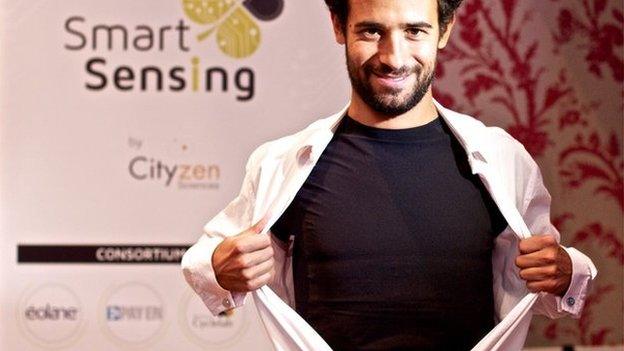CES 2015: Preview of the new tech on show in Las Vegas
- Published
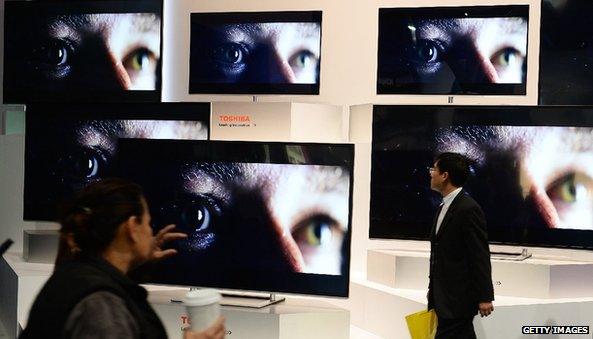
Bigger, thinner, brighter TVs will be just the tip of the iceberg at CES 2015
Millions of gadgets have only just been unwrapped for Christmas, but the giants and minnows of the tech world are gearing up for a fresh barrage.
More than 3,500 firms will exhibit new wares at this years' International Consumer Electronics Show in Las Vegas, on top of the many others there for more private show-and-tells.
Despite questions about the event's relevance in an age when tech firms stage big-budget unveils of their own, CES still pulls a huge crowd.
"It's still the most important event in the calendar across the broader technology landscape," says consultant Ben Keen from IHS Technology, who thinks this might be the 20th time he's attended.
"In the old days it was very much about what were called brown goods - everything around the TV set and related technologies. But now, it's quite extraordinary how many sectors converge."

New TVs
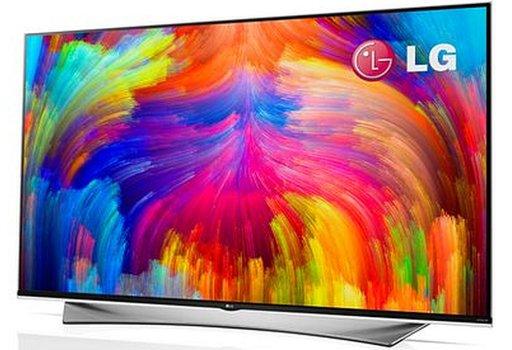
LG suggests its quantum dot televisions will offer better colour accuracy
Living room screens are one of CES's biggest draws.
After the fuss about bendable sets last time round, the focus should be back on picture quality this time.
LG has already revealed it will introduce quantum dot tech, external to its 4K ultra high-definition line-up. This involves using tiny crystals - some of which are 50,000 times smaller than the width of a human hair - to create images, which the firm says results in 30% better colour accuracy than conventional LCD TVs.
Sony has previously used quantum dots in its Triluminos-branded TVs, but LG boasts that unlike its Japanese rival it has been able to do so without involving the toxic substance cadmium - which should make its sets more eco-friendly.
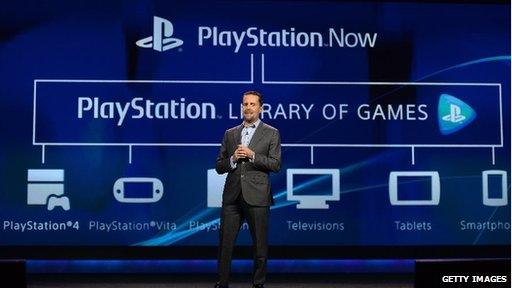
Sony unveiled PlayStation Now at CES in 2014, this year will see TVs that have the gaming facility built-in
Expect LG to also make a fuss about version 2.0 of its webOS smart TV user interface, which promises faster loading apps than the original.
Samsung has revealed it will show off TVs, external that can play PlayStation 3 games without the need for a separate console, thanks to a tie-up with Sony's PS Now streaming video game service.
The South Korean firm has also said all its new smart TVs will run off the Linux-based Tizen operating system, external, already used to power some of its cameras and smartwatches, which could boost app development.
Elsewhere, Sony, Sharp and Philips are expected to show off sets running Android 5.0 (Lollipop) as Google takes yet another crack yet another crack at the sector.

Google has said several TV-makers will support its latest television platform
Keep an eye out too for references to nits. No, not head lice, but a measurement of brightness. More nits means the TV picture should look better in a sunlit room as well as paving the way to "high dynamic range (HDR) imaging - a technology that promises more lifelike pictures.
There should also be news about more 4K content. Amazon and Netflix already stream a limited amount - but the big news would be 4K Blu-ray players offering higher quality video than the net-based services.

Smartphones and smartwatches

Will Samsung's Yoon Boo-Keun offer a first look at the Galaxy S6?
Updates to Sony's Xperia range have been the biggest smartphone launches at CES in recent years - and the firm has already teased an Android Lollipop-powered model, external this time round.
But there are rumours that it will be Samsung that steals the limelight with a first look at its top-end handset.
"I don't think it will do a full reveal, but it may tease the audience with the Galaxy S6," says Ben Wood, from the CCS Insight consultancy.
"Having failed to deliver a winning flagship model in 2014, it really needs to get back on its feet. And that keynote address [by Samsung Electronics chief executive Boo-Keun Yoon on Monday] is going to be the one to go to."
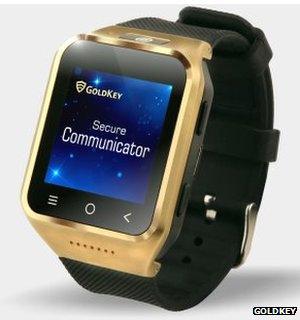
Goldkey says its Android-powered watch can make calls without needing to be paired to a phone
There had also been claims, external that China's bestselling smartphone-maker Xiaomi would unveil a new flagship at CES and announce a move into the US market.
However, a spokeswoman told the BBC: "We won't be participating."
Kodak will, however, be entering the smartphone sector - or at least its brand will be. Bullitt Group, which already makes "rugged" handsets, has paid to use the photography firm's trademark, external for a device that promises to offer new "printing and sharing services".
There will also be a flurry of smartwatch announcements as manufacturers attempt to avoid being overshadowed by Apple's imminent release of its much-discussed Watch.
Goldkey, a little-known brand, has pre-announced, external an Android model that works as an independent wrist telephone.
But Intel's keynote on Tuesday might prove more significant. The chip-maker partnered with watchmaker Fossil in September, external. According to Business Insider, it is also working with Swiss firm Tag Heuer, external.
It would be fascinating if these firms eschew Android and Apple's touchscreen designs for more classical looks, hiding most of their tech away.

The Withings Activité watch uses a dial to tell the user how close they are to completing their fitness goal, leaving it to a smartphone to provide further information
Withings' sleep and activity-tracking Activité watch, which is also on show, has already pioneered such a design.

Wearables

Can a wrist-worn device really deduce the number of calories you have eaten?
Wearable technologies - body-worn devices that wirelessly connect to a smartphone or other computer - are booming.
About 19 million such devices shipped in 2014, according to research firm Berg Insight, more than three times up on 2013.
Most of those were accelerometer-focused activity trackers - CES offers a chance to see what else is possible.
Start-up Healbe will be showing off a device it says can automatically log how many calories you consume. The GoBe tracker raised nearly $1.1m (£694,000) on crowdfunding site Indiegogo despite several critics , externalclaiming it wouldn't work, external. CES is a chance for the Silicon Valley start-up to prove them wrong.
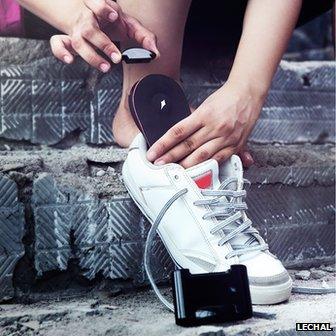
Lechal's Bluetooth-connected insoles are designed to buzz their wearer's feet to provide notifications
Many products are designed to offer specialist data to athletes.
For example, ShotTracker will show off kit for basketball players that records how many shots they attempted, and what percentage were successful. And Wahoo Fitness has a chest band that can count the number of push-ups, sit-ups and other repetitive exercises that have been completed.
India's Lechal is taking a different approach, promoting haptic insoles - devices that slips into your shoes, which your phone can make vibrate. The idea is to provide feedback about fitness performance as well as offer directions by buzzing one foot or the other.
Franc's Novitact has a related idea. Its screenless Feeltact wristband will buzz different parts of the wearer's wrist in different ways to surreptitiously provide different types of notifications.
Leo Kelion checks out the Feeltact wristband
In fact, making wearable tech near-invisible could become a new trend.
Vorbeck promises to show off a racing suit that contains in-built sensors that still work after it has been put in the wash.
And Cityzen Sciences is back at the show with an updated heart rate-reading prototype T-shirt.
Leo Kelion speaks to Cityzen Sciences
Others, such as BlueJewlz and Viawear, will show off tech-embedded pieces of jewellery as they seek to de-geek the sector.

Drones and robots
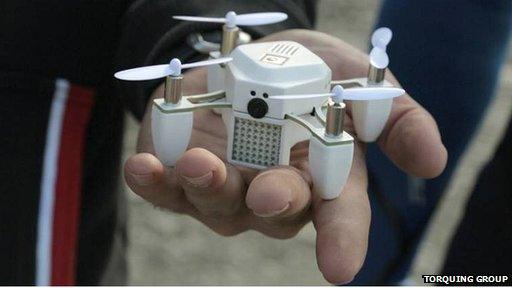
The Zano drone is set to be one of the smallest remote controlled aircraft
Drones get their own section of CES in 2015 with a new "unmanned systems" zone.
Wales' Torquing Group could provide one of its highlights with Zano, a Kickstarter-backed quadcopter small enough to fit in your hand but still capable of high-definition video capture.
Air Dog has recovered from a disastrous demo - which resulted in a wrecked aircraft - to bring its kit to the show. The machine promises to automatically follow its owner while filming them with a GoPro camera. Hexo+ is at the event with a similar product.
The BBC understands GoPro is not ready to announce a drone of its own, despite hosting a presentation on Tuesday, external.
Auto-tracking video drones launched
But one of the industry's pioneers, Parrot, is promising to show off new tech.
Ground-based robots will also try to make their mark.
Japanese firm Doog is hosting a press conference, external to promote laser-equipped droids designed to follow a human round a shopping centre - and presumably explain why that's a good idea.
And Paris-based start-up Keecker will show off a robot that doubles as a movie projector after raising more than quarter-of-a-million dollars for the idea on Kickstarter.
Leo Kelion checks out the Keecker robot
But beyond narrow niches, such as bot-based vacuum cleaners, robots may fail once again to prove they're yet ready to make much headway as consumer products.

Smart home
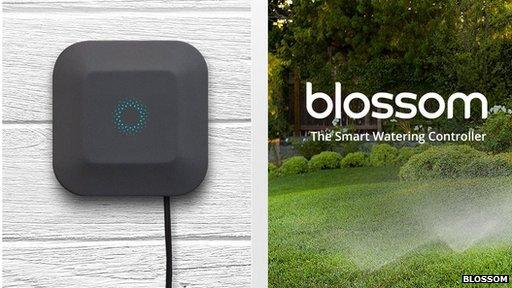
Blossom's internet-connected hub uses weather forecasts to determine when to spray water, and can also be triggered by the owner's smartphone
By contrast, this is the year that "internet of things" and "smart home"-tagged products will make a concerted push to go mainstream.
The idea is to empower everyday objects by letting them create and/or make use of online data.
For example, Blossom will have a garden sprinkler system that can decide when to switch on based on weather forecasts, while SmartQSine is showing off pads for the pantry that allow you to keep track of how much of your favourite foods are left.
Sean DuBravac
It's far from just the start-ups getting involved. Samsung took over smart home developer, external SmartThings last August, and has indicated much of its chief executive's keynote will be dedicated to the topic.
Yet, one expert has doubts about whether this will be the sector's breakout year.
"The current generation of devices is perceived as adding very little value beyond simply being a 'gimmick'," says Hendrik Bartel from tech advisors Gartner.
"Perhaps the first attempt has fallen flat in terms of promoting the value of enhanced energy savings or automation of repetitive tasks, as it would appear to be unable to convince the larger market to take advantage of the connected home."
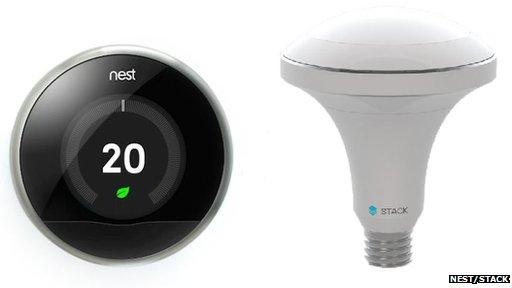
Stack will reveal how its light bulbs can benefit from being linked up to Nest's thermostat
He adds, however that Apple's HomeKit programme - an iOS technology that links up different smart home devices - may have spurred on innovation in some of the products shown at this year's CES.
Google's Nest smart thermostat and smoke alarm could also solidify its place at the heart of a rival ecosystem.
Washing machine-maker Whirlpool will be showing off ways its products can be paired to Nest's kit, while the motion-sensing light bulb maker Stack Lighting is promising a tie-up of its own.
The risk is that all this connected tech will provide a backdoor to hackers. But vendors taking part in CES's new cybersecurity zone will no doubt be keen to provide solutions - for a fee.

3D printers
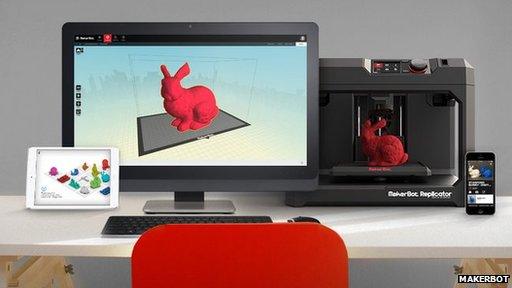
Makerbot will promote its new range of apps at CES
Three years ago there were just two 3D printing firms at CES. This year there promises to be more than two dozen.
But while some large-scale manufacturers are embracing the technology, the general public has still to be convinced it needs such kit in the home.
The risk for attendees is that they come across like me-too makers of machines that slowly churn out plastic knick-knacks destined for the bin.
Makerbot aims to tackle this perception, external with a range of new apps including software to create smartphone cases and a range of retro-looking robots.
3D Systems says it will delve deeper into 3D printer food, external, building on last year's customised chocolates.

Mcor's printers can create intricate 3D objects out of paper
But perhaps most intriguing of all is Mcor.
The Irish company's machines can build detailed, multicoloured 3D objects out of paper and ink.

Connected cars
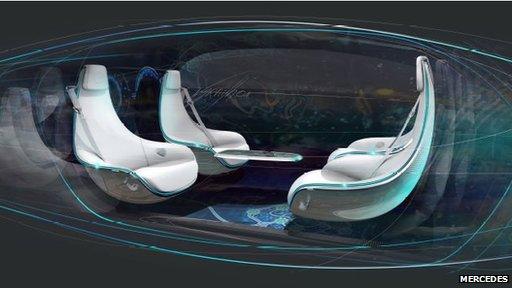
Mercedes has teased a new concept car with this image
Volkswagen will bring the number of car brands on display into double figures for the first time at CES this year.
Despite the Detroit Motor Show being just around the corner, the Las Vegas event has become an important pit stop on the auto calendar.
Mercedes says it will show off a new self-drive concept car that allows its passengers to face each other.
BMW plans to show how one of its cars can be set, external to park itself via a smartwatch app.
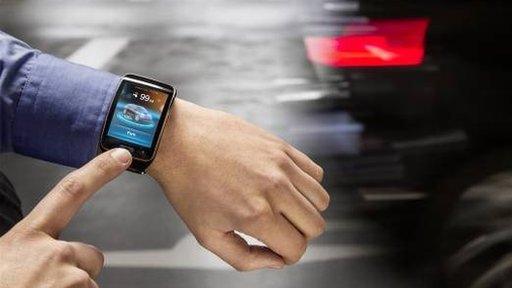
BMW will show how a car can be parked via a smartwatch
And Ford is expected to launch the third-generation of its Sync in-car entertainment and emergency assistance system.
"The story will be about how the car is becoming an extension of the smartphone, and an integral part of the 'internet of things'," says John Curran from Accenture.
"These cars will be able to check where you last had the engine on if you've lost it in a car park, or inform you about how ecologically friendly your driving is.
"We might also see 'mVallet' services on show at CES - these are cars equipped with the tools to allow drivers to confirm card payments directly from their on-board unit."

Other stuff
Tracker tag lets you locate items
Stuff to stop you losing your other stuff is going to be a big theme next week.
Thanks to a low-energy version of Bluetooth catching on, a multitude of firms are launching kit that can help keep track of your children, keys, pets, luggage and more.
Virtual reality is also coming of age.
Facebook's Oculus Rift headset team is back ahead of the expected launch of the helmet later this year. Others will also be at the show promoting add-on hardware designed to help players adapt to a more immersive form of gaming.
Leo Kelion checks out Giroptic's 360 camera
Rivals will offer ways to turn existing smartphones into VR helmets, while Giroptic says it will show off a 360-degree cameras that can create look-wherever-you-want videos for such gear.
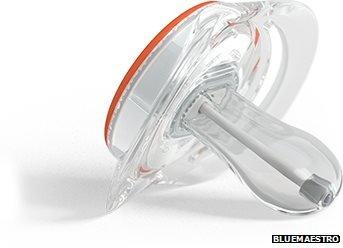
The Pacifi baby's dummy sends their temperature to the parent's smartphone
But it's inevitably the weirder stuff that will attract the most attention.
The BBC has already been contacted by the makers of:
a toothbrush that plays a video game
a baby's dummy that connects to the net
a ring that lets you look at your finger to see how many unread emails you have
a shoe attachment that lets you walk "normally" at speeds of 7mph (11.2km/h)
a dog collar that lets you speak to your pet and view what they see via a smartphone
Leo Kelion looks at the Mybiody Balance device
Just remember, much of what's announced at CES may be conveniently forgotten by its makers long before reaching shop shelves.
Whatever happens at CES, the BBC will bring you news and insights from the event at bbc.co.uk/ces2015.
You can also follow some of the reporters attending on Twitter:
Technology correspondent Rory Cellan-Jones:
North America technology correspondent Richard Taylor:
The rest of the BBC News Online tech desk team:
Click team:
- Published2 January 2015
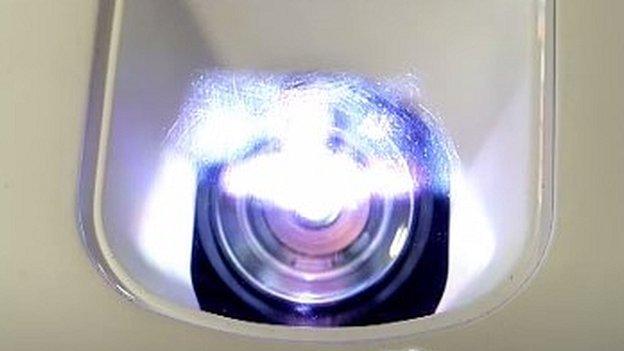
- Published2 January 2015
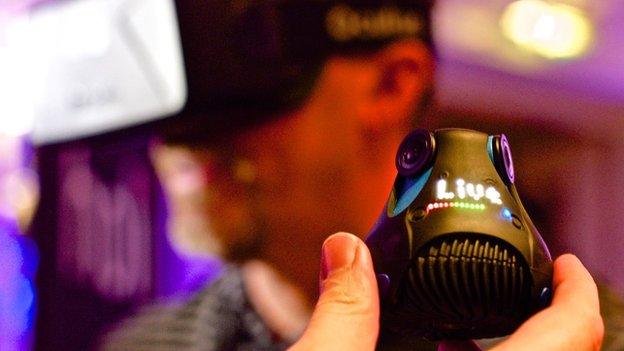
- Published2 January 2015
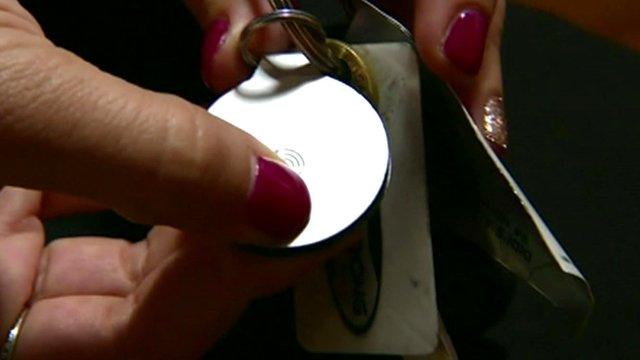
- Published2 January 2015
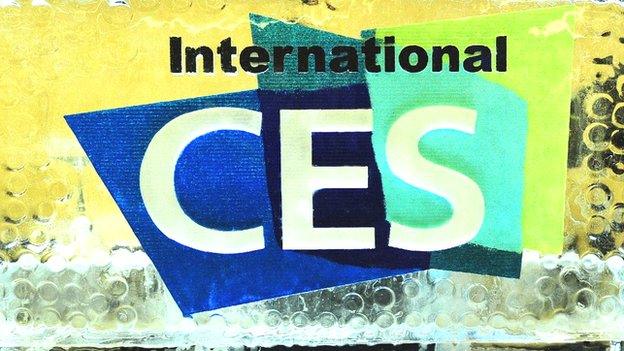
- Published2 January 2015

- Published2 January 2015

- Published2 January 2015
